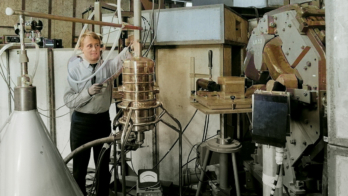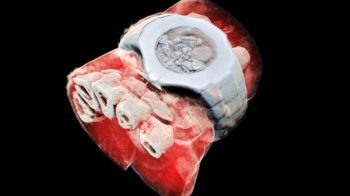On 25 May 2001, Jack Steinberger, who shared the Nobel prize in 1988 and is one of CERN’s stalwarts, reaches his 80th birthday. His memoirs of his early life were published in Annual Reviews of Nuclear Science in 1997 (vol. 47, xiii). Jack is continuing to work on his reminiscences, from which this article pulls together some episodes from the bubble chamber era of the 1950s and 1960s.
Strange particles were first seen in 1947(1) in a cloud chamber of Blackett, triggered by hadron showers produced by cosmic rays. Soon after, other strange particles, then called V particles, were also seen in nuclear emulsions. Progress in our understanding of these new particles was slow, partly because the experimental possibilities were limited to cosmic-ray observations, and partly because the phenomena were so totally outside of what was then known.
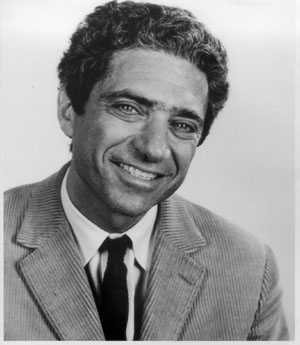
I remember in 1949, on a bulletin board at the Princeton Institute of Advanced Studies, a photomicrograph of a nuclear emulsion event, showing what is now known as a K-meson decaying to three pions. We all saw it. There could be no doubt that something interesting was going on, very different from what was then known, but it was hardly discussed because no-one knew what to do with it.
The copious production of these particles, indicative of the strong interaction, was at odds with their long lifetimes, indicative of the weak interaction. Pais noted in 1952 (2) that this could be understood by inventing a feature of the strong interaction, a selection rule, which would permit their production but forbid their decay via the strong interaction. He implemented this in a mechanism that required the new heavy particles to be produced in pairs. This was extended some months later by Gell-Mann (3), who ingeniously combined the selection rule with the notion of isotopic spin. It required that the pair of Pais be composed of a “strange” and an “antistrange” particle.
Enter the accelerator

The arrival of accelerators of sufficient energy facilitated the study of these new particles enormously. The Brookhaven Cosmotron accelerated protons to 3 GeV, six times the energy of the highest energy cyclotron, and sufficient to produce the new particles in collisions on nuclei, and Ralph Shutt and colleagues had developed a new type of cloud chamber. The V particles produced in cosmic-ray showers had been observed in cloud chambers, but these were very inefficient for accelerator experiments because, once made sensitive by expanding the gas, they would require 1 min of relaxation before they could be expanded again. The accelerator cycle, however, was typically 1 s. The new “diffusion” cloud chamber, in contrast, was continuously sensitive and made it possible to demonstrate the production of strange particles in pairs(4) and verify the hypothesis of Pais and Gell-Mann (figure 1).
Two years later, in 1955, Gell-Mann and Pais (5) noticed that the neutral kaon should exist in two versions, one strange and the other antistrange, one the antiparticle of the other. In addition to the known neutral kaon, there should be another one, with the same mass but with much longer lifetime and with different decays, with opposite symmetry under space inversion.
This idea, which seems obvious now, was not obvious at the time. It was not easy for me to understand or to accept this proposal when I read it, but a few days later T D Lee succeeded in explaining it to me. Once understood, the idea could not be rejected.
The experimental confirmation a year later by Lederman and Landé(6) marked a big step forward. It was also carried out at the Cosmotron, and used what was, to my knowledge, the largest cloud chamber ever, 1 m in diameter. The large size made it more likely that the long-lived kaon, with a decay path of the order of 10 m, would decay inside. The chamber had been built at the Nevis laboratory some years before, but had never found any use. This, to my knowledge, was also the end of the long and glorious career of the cloud chamber in particle physics.
In 1953 Donald Glaser invented the bubble chamber(7), which went on to dominate particle physics, especially strange particle research, for the next 20 years. He showed that energetic particle trajectories can be made visible by photographing the bubbles that form within a few milliseconds after particles have traversed a suitably superheated liquid (figure 2).
The bubble chamber
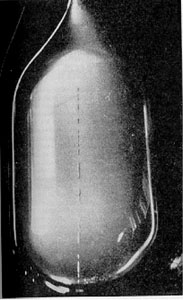
The advantage of the bubble chamber over the cloud chamber at accelerators was two-fold: the higher density of the liquid proportionally increased the number of interactions produced in it, and it was faster to reactivate, matching the frequency of the accelerator cycle.
Within a year, John Woods, in the group of Alvarez at Berkeley, succeeded in producing tracks in liquid hydrogen.(8) The chamber was a metal cylinder to which glass plates were attached, using indium ribbons as seals. In addition to being a major cryogenic technical achievement, this also demonstrated the crucial fact that for use with accelerators, where the expansion can be timed with respect to the accelerator cycle, the bubble chamber environment need not be as ultra-clean as was the glass vessel of Glaser, which permitted the liquid to survive in its superheated state for relatively long periods.
Three graduate students, John Leitner, Nick Samios, Mel Schwartz, and I began work at Nevis on the design of a practical experimental bubble chamber (9) to study strange particle production at the Cosmotron, I think early in 1954. By 1955 we had a 6 inch (15 cm) diameter liquid propane chamber. This was used at the Cosmotron in the first experiment using this new technique. The work profited a great deal from a generous collaboration as well as friendship with the inventor, who was working on a similar project at Brookhaven with his former student, David Rahm. (10)
Rapid action
Our main technical contribution at Nevis was the discovery of a rapid action three-way gas pressure valve, the “Barksdale” valve. This made it possible to recompress the liquid within milliseconds after the expansion, and so to reduce the undesirable thermal effects that result if the pressure remains low for longer times and greater quantities of liquid boil.
As work progressed, we were joined by R Budde from the newly established CERN laboratory, who had been sent to learn about the new technique. The chamber had a serious flaw, which we nevertheless accepted in order to get experimental results – the liquid became clouded and lost its transparency after a few hours of operation. It was then necessary to empty and to refill the chamber, with a consequent loss of time.
The experiment (11)used a pion beam of energy 1300 MeV, only slightly more than the minimum required to produce a strange particle pair. There was no magnetic field, so the particle momenta could not be measured. However, the information from the spatial directions of the observed particles, recorded stereoscopically, sufficed to permit the identification of L hyperon and neutral kaon decays, to distinguish collisions on hydrogen from those on carbon, and so identify the processes we wanted to study (figure 3).
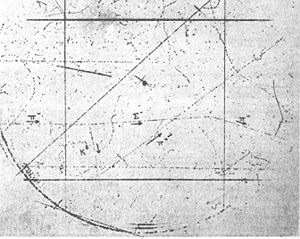
The lifetimes of most of these particles are of the order of 10-10s, and consequently their path length is typically some centimetres. The several dozen events obtained gave the first quantitative measure of the production probabilities and angular distributions for negative pion on proton reactions, giving a positive kaon and a S-, and a neutral kaon and a L. In retrospect, the most interesting result was a precocious glimpse of parity violation, soon to be at the centre of the particle physics stage.
The development of bubble chambers went on apace. Within a year the 10 inch (25 cm) hydrogen chamber of Alvarez was in operation at the Bevatron, which was then, with 5 GeV protons, the world’s highest-energy accelerator, and which had permitted the discovery of the antiproton by Chamberlain, Segrè, Wiegand and Ypsilantis in 1955.(12) In 1959 this was superseded by the 72 inch (1.8 m) chamber, the workhorse of the Bevatron for more than a decade, which led to the discovery of several meson and hyperon resonances.
At Brookhaven the Shutt group made important technical advances. In 1958 its 20 inch (50 cm) chamber came into operation, followed in 1962 by the 80 inch (2 m) chamber. This went on to take 11 million photographs, and the results included the important discovery in 1964 of the triply strange W– hyperon,(13) confirming the SU(3) symmetry proposed by Gell-Mann to account for the multiplet structure and mass regularities of the observed strange particles, and which mothered the invention of the quark (figure 6).
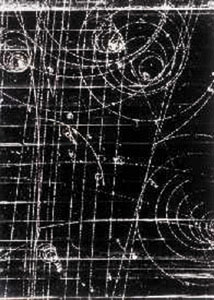
At CERN a 30 cm hydrogen chamber came into operation in 1960, and the 2 m hydrogen chamber in 1964. This became the main CERN tool for the study of resonant and strange particle physics for a decade and kept hundreds of physicists busy and happy. Gargamelle, a very large heavy-liquid (freon) chamber constructed at Ecole Polytechnique in Paris, came to CERN in 1970. It was 2 m in diameter, 4 m long and filled with freon at 20 atm. With a conventional magnet producing a field of almost 2 T, Gargamelle in 1973 was the tool that permitted the discovery of neutral currents.
Further reading
(1) G D Rochester and C C Butler, Nature 160 (1947) 885.
(2) A Pais, Some remarks on the V particles, Phys. Rev. 86 (1952) 663.
(3) M Gell-Mann, Isostopic Spin and New Unstable Particles, Phys. Rev. 92 (1953) 833.
(4) W B Fowler, R P Shutt, A M Thorndike and W L Whittemore, Production of heavy particles by Negative Pions, Phys. Rev. 93 (1956) 861.
(5) M Gell-Mann and A Pais, Behaviour of Neutral Particles under Charge Conjugation, Phys. Rev. 97 (1955) 1387.
(6) K Lande, E T Booth, J Impeduglia, L M Lederman and W Chionowsky, Observation of Long-lived Neutral V-Particles, Phys.Rev. 103 (1956) 1901.
(7) Donald A Glaser, Bubble Chamber Tracks of Cosmic Ray Partilces, Phys. Rev. 91 (1953) 762.
(8) John G Wood, Phys. Rev. 94 (1954) 731.
(9) J Leitner, N Samios, M Schwartz and J Steinberger, Nevis report 10, 1955.
(10) D A Glaser and D C Rahm, Phys. Rev. 97 (1955) 474.
(11) Budde, Chretien, Leitner, Samios, Schwartz and Steinberger, Properties of mHeavy Unstable Particles Produced by 1.3 BeV p– Mesons, Phys. Rev. 103 (1956) 1827.
(12) O Chamberlain, E Segre, C Wiegand and T Ypsilantis, Observations of Antiprotons, Phys. Rev. 100 (1955) 947.
(13) V E Barnes et al, Observation of a Hyperon with Strangeness Minus Three, Phys. Rev. 12 (1964) 204.
(14) R Plano, N Samios, M Schwartz and J Steinberger, Demonstration of the Existence of the So Hyperon and a Measurement of its Mass, Il Nuovo Cimento V, (1957) 216.
(15) F Eisler et al, Demonstration of Parity Non-Conservation in Hyperon Decay, Phys. Rev. 108 (1957) 1353.
(16) F S Crawford et al, Detection of Parity Non-Conservation in L Decay, Phys. Rev. 108 (1957)
1102.
(17) F Eisler et al, Experimental Determination of the L and S– spins, Nuovo Cimento VII , (1958) 222.
(18) A R Erwin, R March, W D Walker and E West, Phys. Rev. Lett.6 (1961) 638.
(19) Allston, Alvarez, Eberhard, Good, Graziano, Ticho and Wojcicki, Phys. Rev. Lett. 5 (1960) 520.
(20) N Gelfand et al, Lifetime of the w Meson, Phys. Rev. Lett. 11 (1963) 436.
(21) N Gelfand et al, Width of the w Meson, Phys. Rev. Lett. 11 (1963) 438.



